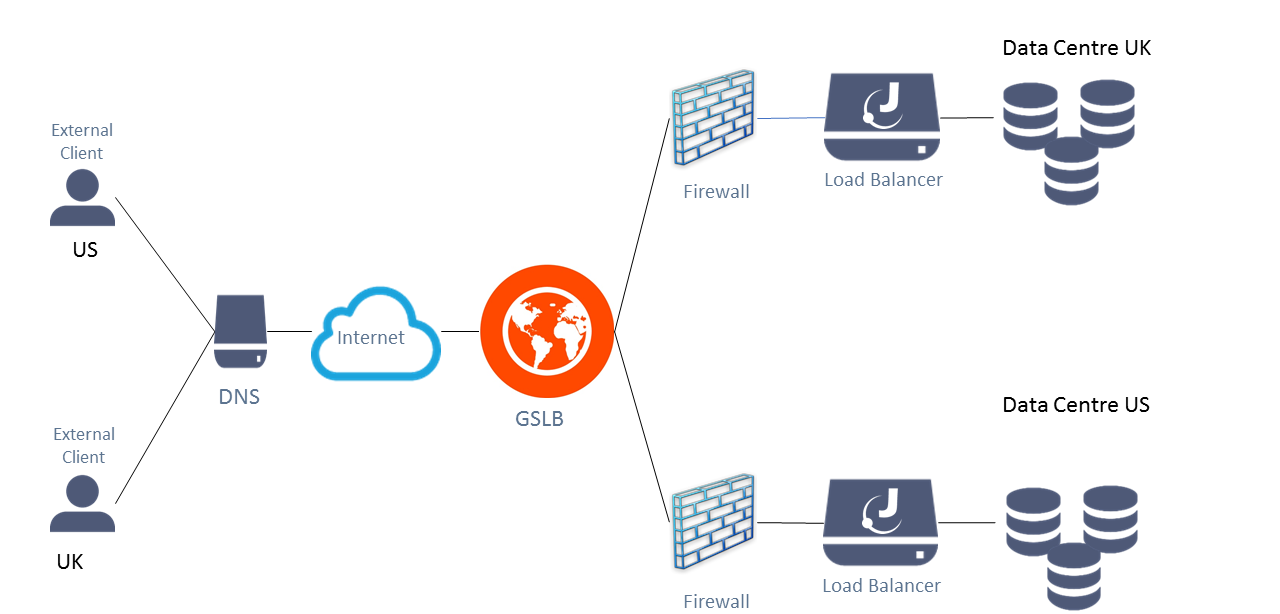Global Server Load Balancing (GSLB) helps in enhancing the performance, reliability, and scalability of web applications.
With the tremendous increase in the number of internet users around the world, web applications experience a hefty amount of traffic.
Therefore, it has become a necessity to facilitate higher availability and optimal performance for web applications.
This is where GSLB helps by distributing incoming traffic across multiple servers or data centers in different locations.
By taking the heavy traffic signal as the input and re-distributing it to other places, this technique enables the users to experience optimal performance even at peak traffic.
In this article, I’ll discuss what GSLB is, the benefits of using it, and how you can enable it.
Let’s begin!
What Is GSLB?
Global Server Load Balancing (GSLB) is a modern network technique that is designed to enhance the performance of web applications and web services with the help of Domain Name System (DNS).
GSLB distributes the traffic by leveraging traffic responses on various factors, including geographic proximity, server load, network latency, and other configurable parameters.

GSLB-powered DNS servers enable the most appropriate response of an IP address with the help of its algorithm. So, whenever a user sends a request for a particular web application, it first gets directed to the DNS server.
GSLB aims to provide the most suitable IP address and ensures the user is directed to the respected data centers that can handle the request efficiently. Thus, the server is not overwhelmed with traffic, and the load is evenly distributed across the multiple servers.
Even when the server or data center is unavailable or faces any issues, the GSLB directs the traffic to other data centers, ensuring uninterrupted service.
GSLB also reduces the latency by providing the data centers to the users who are geographically closest to them. Additionally, it helps reduce the distance the data packets travel, thereby enhancing the user experience by providing a faster response.
How Does GSLB Work?
Domain Name System (DNS) is fundamental to translating domain names into IP addresses. It distributes the web traffic in such a way that the users’ requests are directed to the most appropriate servers.
Any request sent by a client for accessing a web application or server primarily reaches the DNS server. The GSLB-enabled DNS server chooses the best IP address dynamically instead of returning a single IP address.

The GSLB algorithm analyzes the best service possible and returns the signal associated with a few essential parameters. The algorithm of GSBL is either implemented within the DNS server or through a separate GSLB-specific appliance or software.
Furthermore, server load is an essential factor to consider in the GSLB algorithm as it assesses each server’s current capacity and resource utilization. For even distribution, it is preferable to avoid servers that generally experience higher loads.
Another crucial factor is geographical proximity; if the client is physically closer to the server or a data center, it can reduce network latency and improve response time.
It is essential to understand that the GSLB works in the real-time monitoring system and improves the health and load of each server in the GSLB pool. So, whenever any server faces any issues and goes offline, it automatically redirects it to another, better one to ensure uninterrupted service.
How Is GSLB Important?
In today’s digital world, nearly all businesses rely on online applications and services. This is why it is necessary to provide optimal performance when they use these web services. To ensure that, GSLB offers many essential features and benefits like the ones explained below.
Enhanced Performance and User Experience

GSLB distributes the incoming traffic signals across multiple servers and data centers, which helps to divide the load evenly. This helps provide faster response times by reducing latency and request overloads. In contrast, it helps to provide a seamless user experience even during peak traffic scenarios.
High Availability and Fault Tolerance
GSLB ensures redundancy and fault tolerance by distributing traffic across various servers. And if any chance any data center fails, then GSLB provides the best possible server by redirecting to it straight. This minimizes downtime, maintains service continuity, and prevents business revenue loss.
Scalability and Flexibility
As businesses grow, they attract more and more users. Thus, it is essential to have a system that can scale up or down according to the demands. It must easily accommodate a hefty amount of user requests, avoiding any system failure.
With GSLB, resource utilization is optimal as the load is evenly distributed among the expanded servers. Thus, it promotes scalability and helps handle the traffic as per the demands.
Geographic Redundancy and Improved Performance
Multinational companies with a diverse user base can benefit from the geographic redundancy capability of GSLB. It can direct users to the available resources by deploying servers or data centers in different locations. Because of this, the packets will have a shorter distance to travel.
This improves the response time and reduces time latency.
Subsequently, in the case of localized network issues or disasters, GSLB can intelligently reroute traffic to natural resources, ensuring continuous service and minimizing the impact of disruptions.
Disaster Recovery and Business Continuity
GSLB can be an effective way of your organization’s disaster recovery strategy. By automatically redirecting users to alternate resources in case of outages, users experience little to no service disruptions or downtimes.
Incorporating GSLB into their infrastructure also enables businesses to reduce the impacts of hardware failures, natural disasters, or other unforeseen events. Thus, it ensures business continuity while minimizing the financial and reputational risks associated with service interruptions.
Efficient Resource Utilization and Cost Savings
GSLB helps optimize resource utilization across the infrastructure as it distributes traffic evenly among multiple servers. This way, it helps overcome server overloading issues and provides an optimal way of using the available resources.

With GSLB, businesses can work more on enhancing their infrastructure and overall efficiency instead of making costly hardware investments. Optimized resource utilization enables the company to save a hefty amount of money.
How Does GSLB Help in Reducing Latency?
In this highly competitive world, every second is precious; thus, speed and responsiveness are paramount. GSLB plays a pivotal role in reducing latency and improving user experience. Let’s see how.
Geographic Proximity
GSLB leverages geographic proximity to reduce latency by analyzing users’ location and directing them to the nearest server so that the packets travel less quickly.
For instance, if a user in Asia requests access to a web application, GSLB can route their request to a server located within Asia rather than directing it to a server on a different continent. This localized routing significantly reduces latency and improves the overall user experience.
Network Optimization
GSLB monitors real-time packet loss and latency data to ensure and optimize network performance. With the help of this information, GSLB dynamically adjusts its path to the most efficient network routes.

Therefore, if GSLB faces any path with a higher latency rate and packet loss, it will change the traffic path to better network conditions. This proactive network optimization minimizes delays and ensures that user requests are routed through the most efficient network routes. As a result, the response time improves, and latency reduces.
Load Balancing
Effective load balancing is a core GSLB feature that plays an important part in reducing latency. By distributing incoming traffic across multiple servers or data centers, GSLB balances the server load. This prevents any single server from being overwhelmed with requests.
GSLB dynamically adjusts the traffic distribution based on server performance and capacity, ensuring that user requests are routed to the available, most responsive servers.
Health Monitoring and Failover
GSLB incorporates health monitoring and failover mechanisms to mitigate latency in the event of server failures or performance degradation. Through continuous health monitoring, GSLB assesses the condition and performance of servers in a GSLB pool.
Moreover, if a server is experiencing issues or becomes unresponsive, GSLB automatically redirects user requests to alternate healthy servers. This failover capability ensures uninterrupted service and minimizes the impact of latency caused by malfunctioning or overloaded servers.
Traffic Shaping and Prioritization
GSLB enables organizations to shape and prioritize network traffic, reducing latency for critical applications or services. By allocating network resources based on application priorities, GSLB ensures that latency-sensitive applications receive the necessary bandwidth and network resources.
For example, real-time communication applications or high-priority services can be allocated more network bandwidth, giving their traffic higher priority and reducing latency. By prioritizing traffic based on application requirements, GSLB optimizes resource allocation and guarantees that latency-sensitive applications perform at their best, improving overall latency and user experience.
Caching and Content Delivery

GSLB can integrate with caching mechanisms and content delivery networks (CDNs) to minimize latency. Caching involves storing frequently accessed data closer to users, reducing the need to retrieve data from the origin server each time.
GSLB can direct users to cached content, significantly reducing the round-trip time and latency. By leveraging CDNs, GSLB can distribute content across multiple edge servers strategically placed in different locations. This approach ensures that content is delivered from the nearest edge server to the user to keep latency to the minimum and improve response times.
Step-by-Step Guide to Enable GSLB
Step 1: Assess Your Organization’s Requirements
Before implementing GSLB, it’s crucial to assess your specific requirements. Consider factors such as the number of servers or data centers you have, the geographical distribution of your users, the expected traffic load, and the desired level of fault tolerance. Keeping an account of these requirements will help you choose and configure the best GSLB solution that can suit your needs.
Step 2: Choose a GSLB Solution
Selecting the right GSLB solution is essential to enable GSLB in your infrastructure successfully. There are various GSLB solutions available, both hardware-based and software-based. Evaluate their features, scalability, ease of management, and compatibility with your existing infrastructure.
For this, consider load balancing algorithms, health monitoring capabilities, and integration with other networking components.
Step 3: Set Up DNS Configuration

GSLB relies on Domain Name System (DNS) to perform intelligent traffic routing. So, ensure that your DNS infrastructure is configured correctly. You may also need to make changes to your DNS zone files or DNS records. In addition, create the necessary DNS records to represent your servers or data centers. These records will be used by the GSLB solution to direct traffic to the appropriate resources.
Step 4: Configure Health Monitoring
To ensure that GSLB can effectively assess the availability and performance of your servers or data centers. Define health check parameters such as response time thresholds, port availability, and specific URLs or services to monitor.
This enables GSLB to detect any failures or degraded performance and make informed routing decisions based on the health status of each resource.
Step 5: Define Load-Balancing Policies
Determine the load-balancing policies in your organization that will govern the distribution of traffic across your resources. Standard load balancing algorithms include round-robin, least connections, and weighted round-robin.
Select the appropriate algorithm based on your specific requirements. For this, consider factors such as server capacity, network conditions, and the desired distribution of traffic.
Step 6: Configure GSLB Parameters

Configure the GSLB parameters within your chosen GSLB solution. This includes defining the GSLB virtual server, specifying the IP addresses or DNS names of your servers or data centers, and configuring the load-balancing policies.
As needed, set up any additional GSLB features, such as global persistence or content filtering. In addition, ensure that GSLB parameters are correctly mapped to your DNS configuration.
Step 7: Implement GSLB Proxies or Appliances
Depending on your chosen GSLB solution, you may need to deploy GSLB proxies or appliances in your infrastructure. These proxies are intermediaries between the DNS requests and your servers or data centers.
They intercept the DNS queries, perform the necessary load balancing and health checks, and forward the traffic to the appropriate resource. Install and configure the proxies or appliances according to the documentation provided by your GSLB solution.
Step 8: Test and Validate
Thoroughly test and validate your GSLB setup before deploying it in a production environment. Simulate scenarios such as server failures or increased traffic loads to ensure that GSLB functions as expected. Monitor the traffic distribution, response times, and failover behavior.
Identify and address issues or performance bottlenecks to ensure a seamless user experience.
Step 9: Deploy and Monitor

Once you are confident in the functionality of your GSLB setup, deploy it in your production environment. Monitor the GSLB solution closely, monitoring traffic patterns, server health, and overall performance. Regularly review and adjust your GSLB configuration to optimize resource utilization, accommodate changing traffic patterns, and ensure high availability.
Step 10: Fine-Tune and Scale
As your infrastructure evolves, it is essential to fine-tune your GSLB configuration and scale it accordingly. You can do this by:
- Periodically reviewing your load balancing algorithms, health monitoring parameters, and overall GSLB architecture
- Making adjustments based on changing requirements and growth in traffic
- Implementing GSLB across multiple geographical regions to enhance fault tolerance further and reduce latency
Conclusion
Implementing Global Server Load Balancing (GSLB) helps enhance user satisfaction, minimize downtime, preserve revenue streams, and strengthen the overall competitiveness of organizations in today’s digital landscape.
GSLB is crucial for achieving high availability, fault tolerance, and optimized web-based applications and service performance.
You may also explore some high-performance Cloud Load Balancer.

